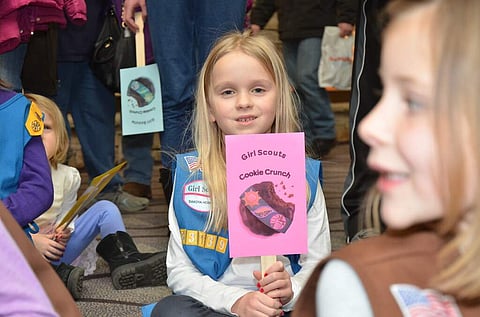

They are two young girls from two very different worlds, linked by a global industry that exploits an army of children. Olivia Chaffin, a Girl Scout in rural Tennessee, was a top cookie seller in her troop when she first heard rainforests were being destroyed to make way for ever-expanding palm oil plantations. On one of those plantations a continent away, 10-year-old Ima helped harvest the fruit that makes its way into a dizzying array of products sold by leading Western food and cosmetics brands.
Ima is among the estimated tens of thousands of children often working alongside their parents in Indonesia and Malaysia, which supply 85 per cent of the world's most consumed vegetable oil. An Associated Press investigation found most earn little or no pay and are routinely exposed to toxic chemicals and other hazardous conditions. Some never go to school or learn to read and write. Others are smuggled across borders and left vulnerable to trafficking or sexual abuse.
The AP used US Customs records and the most recently published data from producers, traders and buyers to trace the fruits of their labor from the processing mills where palm kernels were crushed to the supply chains of many popular kids' cereals, candies and ice creams sold by Nestle, Unilever, Kellogg's, PepsiCo and many other leading food companies, including Ferrero one of the two makers of Girl Scout cookies.
Olivia, who earned a badge for selling more than 600 boxes of cookies, had spotted palm oil as an ingredient on the back of one of her packages, but was relieved to see a green tree logo next to the words certified sustainable. She assumed that meant her Thin Mints and Tagalongs weren't harming rainforests, orangutans or those harvesting the orange-red palm fruit. But later, the whip-smart 11-year-old saw the word mixed on the label and quickly learned it meant exactly what she feared: Sustainable palm oil had been blended with oil from unsustainable sources.
To her, that meant the cookies she was peddling were tainted. Thousands of miles away in Indonesia, Ima led her class in math and dreamed of becoming a doctor. Then her father made her quit school to help meet his high company targets on the palm oil plantation where she was born. Instead of attending fourth grade, she squatted in the unrelenting heat, snatching up the loose kernels littering the ground. She sometimes worked 12 hours a day, wearing only flip flops and no gloves, crying when the fruit's razor-sharp spikes bloodied her hands or scorpions stung her fingers.
The loads she carried went to one of the very mills feeding into the supply chain of Olivia's cookies. I am dreaming one day I can go back to school, she told the AP. Child labor has long been a dark stain on the $65 billion global palm oil industry, identified as a problem by rights groups, the United Nations and the US government. With little or no access to daycare, some young children in both countries follow their parents to the fields.
In some cases, an entire family may earn less in a day than a USD 5 box of Girl Scout Do-si-dos. For 100 years, families have been stuck in a cycle of poverty and they know nothing else than work on a palm oil plantation, said researcher Kartika Manurung, who has published reports detailing labor issues on Indonesian plantations. The AP's investigation into child labor is part of a broader in-depth look at the industry that also exposed rape, forced labor trafficking and slavery.
Reporters crisscrossed Malaysia and Indonesia, speaking to more than 130 current and former workers - some two dozen of them child laborers at nearly 25 companies. Indonesian government officials said they do not know how many children work in the country's massive palm oil industry. But the UN's International Labor Organization has estimated 1.5 million children between 10 and 17 years old labor in its agricultural sector.
Palm oil is one of the largest crops, employing some 16 million people. In much smaller neighboring Malaysia, a newly released government report estimated more than 33,000 children work in the industry there nearly half of them between the ages of 5 and 11. That report did not directly address the tens of thousands of so-called stateless boys and girls living in the country with parents who came from bordering countries.
An official from Malaysia's Ministry of Plantation Industries and Commodities did not respond to repeated requests for comment, but Nageeb Wahab, head of the Malaysian Palm Oil Association, called allegations of child labor very serious and urged complaints to be reported to authorities. Soes Hindharno, an official from Indonesia's Manpower Ministry, said he had not received any complaints about child labor occurring in his own country, but an official from the ministry that oversees women and children's issues labeled it an area of growing concern.
Many producers, Western buyers and banks belong to the 4,000-member Roundtable on Sustainable Palm Oil, a global association that provides a green stamp of approval to those committed to dealing with palm oil that's been certified as ethically sourced. The RSPO has a system in place to address grievances, including labor abuse allegations. But of the nearly 100 complaints listed on its case tracker in the last decade in the two Southeast Asian countries, only a handful have mentioned children.
